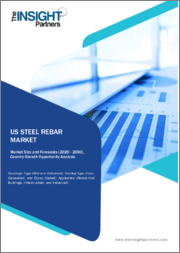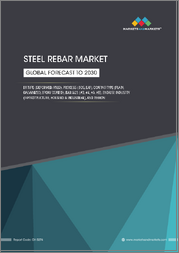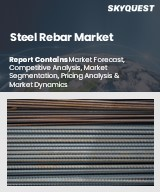
|
시장보고서
상품코드
1408677
미국 철근 시장 : 규모 및 예측, 지역 점유율, 동향, 성장 기회 분석 - 유형별, 코팅 유형별, 용도별US Steel Rebar Market Size and Forecasts, Regional Share, Trends, and Growth Opportunity Analysis Report Coverage: By Type, Coating Type, and Application |
||||||
미국 철근 시장은 2022년 206억 7,000만 달러로 평가되었고 2030년 276억 8,000만 달러로 성장할 것으로 예상되며, 2022년부터 2030년까지 복합 연간 성장률(CAGR) 3.7%로 예상됩니다.
철근은 콘크리트 구조물을 보강 및 강화하는 건설 업계의 중요한 부품입니다. 일반적으로 표면에 리브 가공된 고강도 강철은 강도를 높이기 위해 콘크리트 내에 전략적으로 배치됩니다. 콘크리트는 압축 강도가 우수하지만 인장 강도에는 한계가 있으며 인장 상태에서는 균열이 발생하기 쉽기 때문에이 보강은 매우 중요합니다. 철근 설계에는 유연성과 강도의 신중한 균형이 필요하므로 다양한 구조 하중을 견딜 수 있습니다. 철근 표면의 리브 패턴은 주변 콘크리트와의 결합을 강화하고 미끄러짐을 방지하여 두 재료 사이의 효과적인 하중 전달을 보장합니다. 철근의 사용은 건설에 있어서의 재료간의 시너지 효과의 증거이며, 콘크리트의 압축 강도와 강철의 인장 강도를 조합하는 것으로, 장기간에 걸쳐 다양한 환경 조건이나 하중에 견딜 수 있는 내구성과 탄력성의 특정 구조를 만듭니다.
주택 건설에서 철근은 콘크리트 기초, 기둥 및 보의 보강에 중요한 역할을합니다. 철근이 제공하는 내구성과 강도는 주택 건축의 수명과 구조적 무결성을 보장하는 데 필수적입니다. 이것은 특히 지진이 많은 지역에서는 중요하며, 철근에 의해 지원되는 철근 콘크리트 구조의 사용은 엄격한 안전 기준을 충족시키는 데 필수적입니다. 게다가 지속가능하고 탄력적인 건설방법을 목표로 하는 동향은 철근 수요를 더욱 뒷받침하고 있습니다. 건설업체와 개발자가 에너지 효율이 뛰어나 환경 친화적인 주택 빌딩 건설에 중점을 둔 가운데 철근을 특징으로 하는 철근 콘크리트의 사용은 이러한 목적에 부합합니다. 철근 재활용성과 구조물의 긴 수명화 능력은 주택 건설 프로젝트의 전반적인 지속가능성에 기여합니다. 주택 건설 부문은 민간 및 미국 정부의 투자 증가로 확대되고 있습니다. 예를 들어, 2021년에는 미국 정부도 합리적인 가격의 주택 제공에 주력하고 있습니다. BBB 계획의 일환으로 정부는 저렴한 주택 규정에 1,500억 달러의 투자를 할당하고 전국에서 100 만 호 이상의 저렴한 주택을 건설 및 개수합니다. 이러한 정부 투자 증가는 주택 건축자재 수요를 증가시키고 미국 철근 시장의 성장을 뒷받침할 것으로 예상됩니다. 특히 습도가 높은 지역과 해수에 가까운 지역에서는 비부식성 특성이 건축자재에서 점점 더 중요해지고 있습니다. 전통적인 철근은 부식의 영향을 받기 쉽고 시간이 지남에 따라 건물의 구조적 무결성을 손상시킬 수 있습니다. 비부식성 철근 수요는 긴 수명과 내구성을 제공하고, 유지 보수 비용을 줄이고, 수명에 걸쳐 구조물의 안전성과 안정성을 확보하기 위해 급증하고 있습니다. 따라서 경량, 고강도 및 비부식성 철근에 대한 수요가 증가함에 따라 미국 철근 시장의 성장이 촉진됩니다.
또한, 철근은 콘크리트 구조물에 중요한 보강을 제공하기 때문에 주택 건축에 중요한 역할을합니다. 철근은 일반적으로 주택의 기초에 사용되며 인장 강도를 높이기 위해 콘크리트 내에 전략적으로 배치됩니다. 이 보강은 기초가 건물의 구조적 하중을 견딜 수 있도록 장기적인 안정성과 내구성을 보장합니다. 철근은 철근 콘크리트의 기둥과 보를 구축하기 위해 주택 건설에 자주 사용됩니다. 이러한 요소는 건물의 전반적인 골격을 지원하고 하중을 효율적으로 분산하고 구조적 파괴를 방지합니다. 기둥과 보에 철근을 사용하여 바람과 지진, 구조물의 무게 등 외력에 대한 건물의 저항력에 공헌합니다.
또한, 철근은 주택 내의 슬래브 및 바닥 시스템의 건설에도 적용됩니다. 철근 콘크리트의 슬래브는 1층이든 상층이든 상관없이 배치된 철근이 제공하는 추가적인 강도와 유연성으로 이익을 얻습니다. 주택에서는 철근 콘크리트 벽에 철근이 필수적입니다. 이 용도는 벽의 내력과 측면 힘에 대한 저항력을 향상시킵니다. 또한, 철근은 발코니, 계단 및 기타 구조 요소의 건설에도 사용되어 주택 건물의 전반적인 안전과 무결성에 기여합니다. 이러한 주택건설로부터 수요의 급증은 미국의 철근시장 성장을 가속할 것으로 예상됩니다.
미국 철근시장에서 사업을 전개하고 있는 주요 기업은 Steel Edge Inc, InteRebar Fabricators LLC, JJ Rebar Corp, Pacific Steel Group, PJs Rebar Inc, Integrity Rebar Placers, Nucor Harris Rebar Inc, Cambrin Steel Services Inc, Northern Nevada Rebar Inc, Bellis Steel Co Inc 등입니다. 이 시장에서 사업을 전개하는 기업은 고객의 요구를 충족시키기 위해 고품질의 혁신적인 제품 개발에 매우 주력하고 있습니다.
미국의 철근 시장 전체의 규모는 1차 정보와 2차 정보 모두를 이용하여 도출되었습니다. 철저한 2차 조사는 시장과 관련된 질적 및 양적 정보를 얻기 위해 사내외의 출처를 이용하여 실시하였습니다. 또한 데이터를 검증하고 보다 분석적인 인사이트을 얻기 위해 업계 관계자들에게 다수의 1차 인터뷰를 실시했습니다. 이 프로세스의 진출기업에는 부사장, 시장 개척 매니저, 마켓 인텔리전스 매니저, 국내 영업 매니저 등의 업계 전문가와 미국 철근 시장을 전문으로 하는 밸류에이션 전문가, 조사 분석가, 키오피니언 리더 등 외부 컨설턴트가 포함됩니다.
목차
제1장 서론
제2장 주요 요약
- 주요 인사이트
- 시장의 매력
- 미국 시장 매력도 - 용도별
제3장 조사 방법
- 조사 범위
- 2차 조사
- 1차 조사
제4장 미국 철근 시장 상황
- Porter's Five Forces 분석
- 공급기업의 협상력
- 구매자의 협상력
- 신규 참가업체의 위협
- 기업 간의 경쟁 관계
- 대체품의 위협
- 잠재고객 목록
- 생태계 분석
- 원재료 공급자
- 제조업체
- 유통업체 또는 공급업체
- 최종 이용 산업
제5장 미국의 철근 시장 : 주요 시장 역학
- 시장 성장 촉진요인
- 주택건설 부문의 성장
- 경량, 고강도, 비부식성 철근 수요 증가
- 시장 성장 억제요인
- 원재료 가격 변동
- 시장 기회
- 인프라 정비 투자 증가
- 향후의 동향
- 지속 가능한 제조 공정 개발
- 영향 분석
제6장 미국 철근 시장 : 미국 시장 분석
- 철근 시장 수익(킬로톤)
- 철근 시장 수익
- 철근 시장 예측과 분석
제7장 미국 철근 시장 분석 - 유형별
- 연질
- 이형
제8장 미국 철근 시장 분석 - 코팅 유형별
- 일반
- 아연 도금
- 에폭시 도장
제9장 미국 철근 시장 분석 - 용도별
- 주택
- 인프라
- 산업
제10장 COVID-19 팬데믹이 미국 철근 시장에 미치는 영향
- COVID-19 전후의 영향
제11장 업계 정세
- 시장 이니셔티브
제12장 경쟁 구도
- 히트맵 분석 - 주요 기업별
- 각사의 포지셔닝과 집중도
제13장 기업 프로파일
- Steel Edge Inc
- InteRebar Fabricators LLC
- JJ Rebar Corp
- Pacific Steel Group
- PJs Rebar Inc
- Integrity Rebar Placers
- Nucor Harris Rebar Inc
- Camblin Steel Services Inc
- Northern Nevada Rebar Inc
- Bellis Steel Co Inc
제14장 부록
BJH 24.01.26The US steel rebar market is expected to grow from US$ 20.67 billion in 2022 to US$ 27.68 billion by 2030; it is expected to register a CAGR of 3.7% from 2022 to 2030.
Steel rebar is a critical component in the construction industry, reinforcing and strengthening concrete structures. The increasingly high-strength steel, typically with ribbed surfaces, is strategically placed within concrete to enhance strength. This reinforcement is crucial because concrete excels in compression but has limited tensile strength and is prone to cracking under tension. The design of steel rebar involves a careful balance of flexibility and strength, allowing it to withstand various structural loads. The ribbed patterns on the surface of the rebar enhance its bond with the surrounding concrete, preventing slippage and ensuring effective load transfer between the two materials. The use of steel rebar is a testament to the synergy between materials in construction, combining the compression strength of concrete with the tensile strength of steel to create durable and resilient structures capable of withstanding diverse environmental conditions and loads over time.
In residential construction, steel rebar plays a crucial role in reinforcing concrete foundations, columns, and beams. The durability and strength provided by steel rebar are essential for ensuring the longevity and structural integrity of residential buildings. This is particularly significant in regions prone to seismic activity, where the use of reinforced concrete structures supported by steel rebar is essential for meeting stringent safety standards. Additionally, the trend toward sustainable and resilient construction practices further supports the demand for steel rebar. As builders and developers focus on constructing energy-efficient and environmentally friendly residential buildings, the use of reinforced concrete featuring steel rebar aligns with these objectives. Steel rebar's recyclability and ability to enhance structures' longevity contribute to the overall sustainability of residential construction projects. The residential construction sector is expanding with growing private and US government investments. For instance, in 2021, the US government is also focusing on providing affordable housing. As part of the BBB plan, the government allocated an investment of US$ 150 billion on affordable housing provisions to construct and rehabilitate over 1 million affordable homes across the country. This increased government investment is expected to increase the demand for residential construction materials, which is expected to boost the US steel rebar market growth. Noncorrosive properties are becoming increasingly important in construction materials, especially in areas with high humidity or proximity to saltwater. Traditional rebars are susceptible to corrosion, which can compromise the structural integrity of a building over time. The demand for noncorrosive steel rebars has upsurged as they offer longevity and durability, reducing maintenance costs and ensuring the safety and stability of structures over their lifespan. Thus, the rising demand for lightweight, high-strength, and noncorrosive rebars drives the US steel rebar market growth.
Moreover, Steel rebars play a vital role in the construction of residential buildings as they provide crucial reinforcement to concrete structures. The rebars are commonly used in the foundation of homes, where they are strategically placed within the concrete to enhance its tensile strength. The reinforcement helps the foundation withstand the structural loads the building imposes, ensuring stability and durability over time. Steel rebars are often used in residential construction to construct reinforced concrete columns and beams. These elements support the overall framework of the building, distributing loads efficiently and preventing structural failure. Using rebars in columns and beams contributes to the building's ability to resist external forces, such as wind, earthquakes, and the structure's weight.
Moreover, steel rebars have applications in the construction of slabs and floor systems within residential buildings. Reinforced concrete slabs benefit from the added strength and flexibility provided by properly placed rebars, whether for ground floors or upper levels. In the context of residential buildings, steel rebars are essential in reinforced concrete walls. This application enhances the walls' load-bearing capacity and resistance to lateral forces. Additionally, rebars may be used in constructing balconies, stairs, and other structural elements, contributing to the overall safety and integrity of the residential buildings. Surging demand from these residential construction is expected to drive the US steel rebar market growth.
A few key players operating in the US steel rebar market are Steel Edge Inc, InteRebar Fabricators LLC, JJ Rebar Corp, Pacific Steel Group, PJ's Rebar Inc, Integrity Rebar Placers, Nucor Harris Rebar Inc, Camblin Steel Services Inc, Northern Nevada Rebar Inc, and Bellis Steel Co Inc. Players operating in the market are highly focused on developing high-quality and innovative product offerings to fulfill customers' requirements.
The overall US steel rebar market size has been derived using both primary and secondary sources. Exhaustive secondary research has been conducted using internal and external sources to obtain qualitative and quantitative information related to the market. Also, multiple primary interviews have been conducted with industry participants to validate the data and gain more analytical insights into the topic. The participants of this process include industry experts, such as VPs, business development managers, market intelligence managers, and national sales managers-along with external consultants, such as valuation experts, research analysts, and key opinion leaders-specializing in the US steel rebar market.
Reasons to Buy:
- Progressive industry trends in the US steel rebar market to help players develop effective long-term strategies
- Business growth strategies adopted by developed and developing markets
- Quantitative analysis of the US steel rebar market
- Estimation of the demand for steel rebar across various industries
- Porter’s five forces analysis provide a 36NA-degree view of the US steel rebar market
- Recent developments to understand the competitive market scenario and the demand for steel rebar in the US scenario.
- Market trends and outlook coupled with factors driving and restraining the growth of the US steel rebar market.
- Decision-making process by understanding strategies that underpin commercial interest concerning the US steel rebar market growth
- The US steel rebar market size at various nodes of market
- Detailed overview and segmentation of the US steel rebar market as well as its dynamics in the industry
- The US steel rebar market size in different regions with promising growth opportunities
Table Of Contents
1. Introduction
- 1.1 The Insight Partners Research Report Guidance.
- 1.2 Market Segmentation
2. Executive Summary
- 2.1 Key Insights
- 2.2 Market Attractiveness
- 2.2.1 Market Attractiveness for US, by Application
3. Research Methodology
- 3.1 Coverage
- 3.2 Secondary Research
- 3.3 Primary Research
4. Steel Rebar Market Landscape
- 4.1 Overview
- 4.2 Porter's Five Forces Analysis
- 4.2.1 Bargaining Power of Suppliers
- 4.2.2 Bargaining Power of Buyers
- 4.2.3 Threat of New Entrants
- 4.2.4 Intensity of Competitive Rivalry
- 4.2.5 Threat of Substitutes
- 4.3 List of Potential Customers
- 4.4 Ecosystem Analysis
- 4.4.1 Raw Material Suppliers:
- 4.4.2 Manufacturers:
- 4.4.3 Distributors or Suppliers:
- 4.4.4 End Use Industry:
5. US Steel Rebar Market - Key Market Dynamics
- 5.1 Market Drivers
- 5.1.1 Growing Residential Construction Sector
- 5.1.2 Increasing Demand for Lightweight, High Strength, and Noncorrosive Rebars
- 5.2 Market Restraints
- 5.2.1 Fluctuating Raw Material Prices
- 5.3 Market Opportunities
- 5.3.1 Increasing Investments in Infrastructure Development
- 5.4 Future Trends
- 5.4.1 Development of a Sustainable Manufacturing Process
- 5.5 Impact Analysis
6. Steel Rebar Market - US Market Analysis
- 6.1 Steel Rebar Market Revenue (Kilo Tons)
- 6.2 Steel Rebar Market Revenue (US$ Billion)
- 6.3 Steel Rebar Market Forecast and Analysis
7. Steel Rebar Market Analysis - Type
- 7.1 Mild
- 7.1.1 Overview
- 7.1.2 Mild Market Volume, Revenue and Forecast to 2030 (US$ Billion)
- 7.2 Deformed
- 7.2.1 Overview
- 7.2.2 Deformed Market Volume, Revenue and Forecast to 2030 (US$ Billion)
8. Steel Rebar Market Analysis - Coating Type
- 8.1 Plain
- 8.1.1 Overview
- 8.1.2 Plain Market, Volume, Revenue and Forecast to 2030 (Kilo Tons) (US$ Billion)
- 8.2 Galvanized
- 8.2.1 Overview
- 8.2.2 Galvanized Market, Volume, Revenue and Forecast to 2030 (Kilo Tons) (US$ Billion)
- 8.3 Epoxy Coated
- 8.3.1 Overview
- 8.3.2 Epoxy Coated Market, Volume, Revenue and Forecast to 2030 (Kilo Tons) (US$ Billion)
9. Steel Rebar Market Analysis - Application
- 9.1 Residential Buildings
- 9.1.1 Overview
- 9.1.2 Residential Buildings Market, Revenue, and Forecast to 2030 (US$ Billion)
- 9.2 Infrastructure
- 9.2.1 Overview
- 9.2.2 Infrastructure Market Revenue, and Forecast to 2030 (US$ Billion)
- 9.3 Industrial
- 9.3.1 Overview
- 9.3.2 Industrial Market Revenue and Forecast to 2030 (US$ Billion)
10. Impact of COVID-19 Pandemic on US Steel Rebar Market
- 10.1 Pre & Post Covid-19 Impact
11. Industry Landscape
- 11.1 Overview
- 11.2 Market Initiative
12. Competitive Landscape
- 12.1 Heat Map Analysis By Key Players
- 12.2 Company Positioning & Concentration
13. Company Profiles
- 13.1 Steel Edge Inc
- 13.1.1 Key Facts
- 13.1.2 Business Description
- 13.1.3 Products and Services
- 13.1.4 Financial Overview
- 13.1.5 SWOT Analysis
- 13.1.6 Key Developments
- 13.2 InteRebar Fabricators LLC
- 13.2.1 Key Facts
- 13.2.2 Business Description
- 13.2.3 Products and Services
- 13.2.4 Financial Overview
- 13.2.5 SWOT Analysis
- 13.2.6 Key Developments
- 13.3 JJ Rebar Corp
- 13.3.1 Key Facts
- 13.3.2 Business Description
- 13.3.3 Products and Services
- 13.3.4 Financial Overview
- 13.3.5 SWOT Analysis
- 13.3.6 Key Developments
- 13.4 Pacific Steel Group
- 13.4.1 Key Facts
- 13.4.2 Business Description
- 13.4.3 Products and Services
- 13.4.4 Financial Overview
- 13.4.5 SWOT Analysis
- 13.4.6 Key Developments
- 13.5 PJ's Rebar Inc
- 13.5.1 Key Facts
- 13.5.2 Business Description
- 13.5.3 Products and Services
- 13.5.4 Financial Overview
- 13.5.5 SWOT Analysis
- 13.5.6 Key Developments
- 13.6 Integrity Rebar Placers
- 13.6.1 Key Facts
- 13.6.2 Business Description
- 13.6.3 Products and Services
- 13.6.4 Financial Overview
- 13.6.5 SWOT Analysis
- 13.6.6 Key Developments
- 13.7 Nucor Harris Rebar Inc
- 13.7.1 Key Facts
- 13.7.2 Business Description
- 13.7.3 Products and Services
- 13.7.4 Financial Overview
- 13.7.5 SWOT Analysis
- 13.7.6 Key Developments
- 13.8 Camblin Steel Services Inc
- 13.8.1 Key Facts
- 13.8.2 Business Description
- 13.8.3 Products and Services
- 13.8.4 Financial Overview
- 13.8.5 SWOT Analysis
- 13.8.6 Key Developments
- 13.9 Northern Nevada Rebar Inc
- 13.9.1 Key Facts
- 13.9.2 Business Description
- 13.9.3 Products and Services
- 13.9.4 Financial Overview
- 13.9.5 SWOT Analysis
- 13.9.6 Key Developments
- 13.10 Bellis Steel Co Inc
- 13.10.1 Key Facts
- 13.10.2 Business Description
- 13.10.3 Products and Services
- 13.10.4 Financial Overview
- 13.10.5 SWOT Analysis
- 13.10.6 Key Developments



















